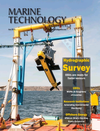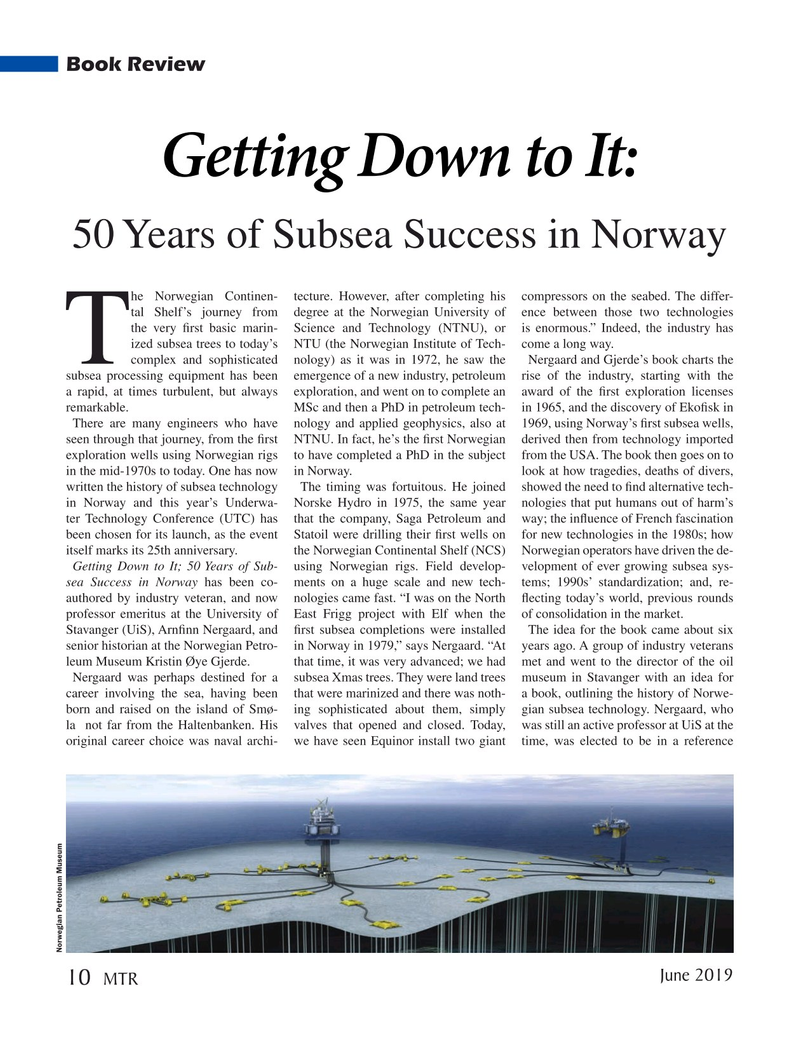
Page 10: of Marine Technology Magazine (June 2019)
Hydrographic Survey: Single & Multibeam Sonar
Read this page in Pdf, Flash or Html5 edition of June 2019 Marine Technology Magazine
Book Review
Getting Down to It: 50 Years of Subsea Success in Norway he Norwegian Continen- tecture. However, after completing his compressors on the seabed. The differ- tal Shelf’s journey from degree at the Norwegian University of ence between those two technologies the very ? rst basic marin- Science and Technology (NTNU), or is enormous.” Indeed, the industry has ized subsea trees to today’s NTU (the Norwegian Institute of Tech- come a long way.
Tcomplex and sophisticated nology) as it was in 1972, he saw the Nergaard and Gjerde’s book charts the subsea processing equipment has been emergence of a new industry, petroleum rise of the industry, starting with the a rapid, at times turbulent, but always exploration, and went on to complete an award of the ? rst exploration licenses remarkable. MSc and then a PhD in petroleum tech- in 1965, and the discovery of Eko? sk in
There are many engineers who have nology and applied geophysics, also at 1969, using Norway’s ? rst subsea wells, seen through that journey, from the ? rst NTNU. In fact, he’s the ? rst Norwegian derived then from technology imported exploration wells using Norwegian rigs to have completed a PhD in the subject from the USA. The book then goes on to in the mid-1970s to today. One has now in Norway. look at how tragedies, deaths of divers, written the history of subsea technology The timing was fortuitous. He joined showed the need to ? nd alternative tech- in Norway and this year’s Underwa- Norske Hydro in 1975, the same year nologies that put humans out of harm’s ter Technology Conference (UTC) has that the company, Saga Petroleum and way; the in? uence of French fascination been chosen for its launch, as the event Statoil were drilling their ? rst wells on for new technologies in the 1980s; how itself marks its 25th anniversary. the Norwegian Continental Shelf (NCS) Norwegian operators have driven the de-
Getting Down to It; 50 Years of Sub- using Norwegian rigs. Field develop- velopment of ever growing subsea sys- sea Success in Norway has been co- ments on a huge scale and new tech- tems; 1990s’ standardization; and, re- authored by industry veteran, and now nologies came fast. “I was on the North ? ecting today’s world, previous rounds professor emeritus at the University of East Frigg project with Elf when the of consolidation in the market.
Stavanger (UiS), Arn? nn Nergaard, and ? rst subsea completions were installed The idea for the book came about six senior historian at the Norwegian Petro- in Norway in 1979,” says Nergaard. “At years ago. A group of industry veterans leum Museum Kristin Øye Gjerde. that time, it was very advanced; we had met and went to the director of the oil
Nergaard was perhaps destined for a subsea Xmas trees. They were land trees museum in Stavanger with an idea for career involving the sea, having been that were marinized and there was noth- a book, outlining the history of Norwe- born and raised on the island of Smø- ing sophisticated about them, simply gian subsea technology. Nergaard, who la not far from the Haltenbanken. His valves that opened and closed. Today, was still an active professor at UiS at the original career choice was naval archi- we have seen Equinor install two giant time, was elected to be in a reference
Norwegian Petroleum Museum June 2019 10
MTR
MTR #5 (1-17).indd 10 5/24/2019 9:34:15 AM

 9
9

 11
11
